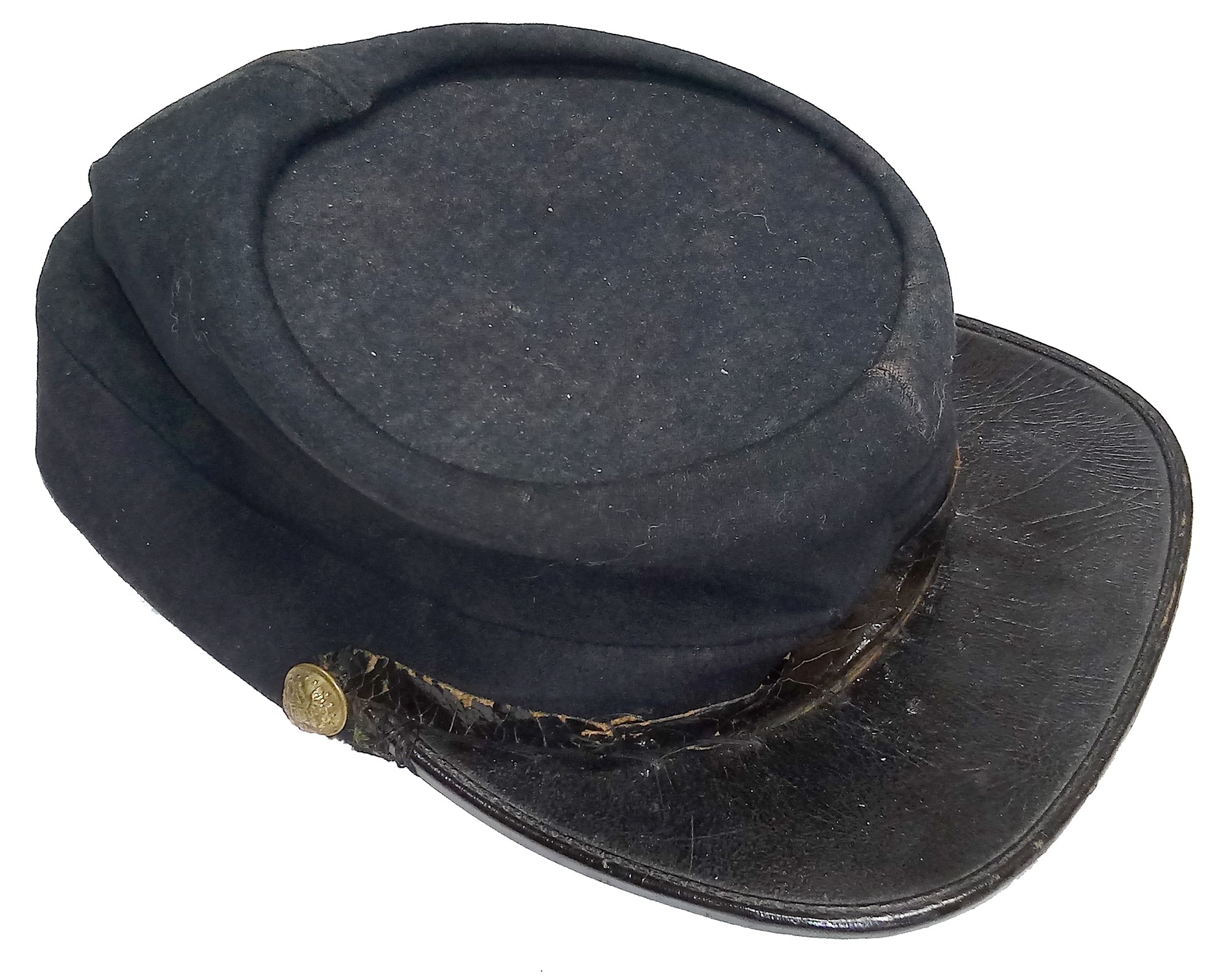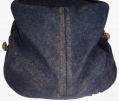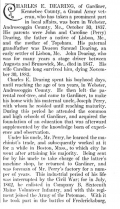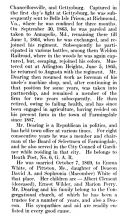site search
online catalog
IDENTIFIED WARTIME KEPI OF CHARLES E. DEARING, 16th MAINE, MARKED AND SOLD BY J.W. CURRIER, ARMY TRADE AGENT AT CITY POINT, VA, 1864-1865

$4,500.00 SOLD
Quantity Available: None
Item Code: 766-1092
Charles E. Dearing served as corporal, sergeant and first sergeant in the 16th Maine, seeing action at Fredericksburg and Gettysburg, where he was captured. Returning to the regiment in late May 1864, he was with them for Grant’s Overland Campaign against Richmond and Petersburg, in which they saw heavy action as part of the Fifth Corps. He was appointed regimental quartermaster sergeant in December 1864 and was mustered out with the regiment in June 1865.
This is a very nice, wartime, low-crowned kepi with a flat, bound visor. The chinstrap is in place, secured on one side with a small staff button and the other with a small general service button that was replaced in the period. The fabric is very good, with good color, just minor handling to the top front rolled edge of the crown where one might touch it to pick it up, and no moth damage. The interior is very good as well. The sweatband is in place, with just a few wear spots, and is intact and secure. The cap is lined in black on the sides and underside of the top, which is quilted and bears a gilt embossed trademark showing an American eagle with spread wings at top and “J.W. CURRIER / DEALER IN OFFICERS / CLOTHING & EQUIPMENTS / CITY POINT, VA” below. The embossing is very good with minor rubbing to the gilt from wear, but very clear lettering. The right half of the bottom is rubbed at bottom, but the imprint is plain and there is no doubt about the lettering.
J.W. Currier was a clerk and businessman who had served as sergeant in the 10th Massachusetts from June 1861 until January 1862, when he accepted a commission as 1st Lieutenant and Adjutant of the First East Virginia Volunteers, This was a U.S. regiment of loyal Virginians that never got beyond company strength, and Currier resigned in mid-May 1862. In January 1863 he was offered a commission in the Pay Department, but turned it down in favor of operating as an army “trade agent.” In June 1864 he was licensed by the Provost Marshal’s office and allowed to set up operations at City Point, the immense Union supply depot established at the confluence of the Appomattox and the James Rivers, and also the place where Grant established his headquarters.
Currier’s trademark indicates he specialized in officers’ clothing and equipments and this cap is typical of the caps available for private purchase on the commercial market. Currier’s merchandise was likely available to noncommissioned officers as well, and as quartermaster sergeant and member of the regiment’s NCO staff from mid-December 1864, Dearing would certainly have been at City Point. A photo of Sergeant Major Manley of the 16th, in Dearing’s effects, shows him in an officer’s style frock coat and wearing the same sort of low-crowned kepi.
Identified wartime caps, especially real kepis, are scarce, and Dearing has a good record in a fighting regiment. Currier is a known dealer, but rare, and he is specifically connected to Grant’s final campaign. This is a cap worth acquiring. [sr]
GENEALOGICAL NOTES
Charles Edwin Dearing was born 30 October 1838 in Webster, Maine, one of eight children born to John (b. ca. 1798) and Caroline Perry Dearing 9 (b. 1806.) John was a stage driver. The union produced 8 children: Joseph H. (born ca. 1832, ) George G. 1834,) Albert Lincoln (ca. 1836,) Charles E. (1838,) John F. (ca. 1840,) Susan E. (ca. 1842,) Laura S. (ca. 1845,) and Bradford P. (ca. 1848.)
John Dearing (Sr.) died 27 September 1847 and the family thereafter is found listed in household of son Joseph H. Dearing in Webster, listed as a farmer. George is not listed in the household in 1850 and presumably is on his own by then. The farm may have been the family homestead, inherited by Joseph as eldest son. George shows up in 1863 in Thanksgiving letter to Charles, a reference in Albert’s (Lincoln’s) letter to Charles, and in reports of Caroline’s 1863 remarriage at “the home of her son George.”
At age ten (about 1848) Charles was sent to Gardiner, ME, to live with his maternal uncle Joseph Perry, a machinist, and train in that profession. In the 1850 census he is listed both in Webster (in the Perry household) and in Gardiner. “After attaining his majority,” presumably ca. 1856, Charles moved to Boston, but returned to Gardiner to manage his uncle’s machine shop and is there by the time of the 1860 census. He is listed in Webster in Joseph’s household, but also seems to have had lodging in Gardiner, where appears as machinist, age 22, in the household of Henry Foy.
By 1860 Joseph had married (Susan V. Dearing) and had one son (John L. Dearing.) Albert L. had served briefly in the U.S. Army, but had been discharged and was again at home. George is on his own. John F. is not listed. Some secondary sources indicate he died 5 October 1858. An 1863 Thanksgiving letter to Charles from the family indicates two family members were absent: Charles and another male member of the family who had died (John L., son of Joseph H., was still alive in 1870.)
Caroline Perry Dearing remarried in April 1863. Her second husband was Willis Sprague, a deacon, one-time state senator, and resident of Topsham. The family’s 1863 letter to Charles referring to “Father” must mean Sprague. The letter is being written from the “old homestead” in Gardiner and Caroline is referred to as “a visitor.” Willis Sprague dies in 1867 or 1869 and by the 1870 census Caroline is once again in the household of Joseph H. in Gardiner. She dies in 1882 at age 76.
Albert Lincoln Dearing served in the 5th Maine, reaching the rank of Captain. He was seriously wounded at Second Fredericksburg (Sedgwick’s attack during the Chancellorsville campaign,) and discharged in 9/8/1863.
CHARLES E. DEARING SERVICE NOTES
Charles E. Dearing was a machinist when he enlisted 26 July 1862 at age 24 and mustered into Co. B 16th Maine on 14 August 1862 as a corporal. The regiment moved to Washington and in October was assigned to the First Army Corps of the Army of the Potomac.
Dearing is recorded as promoted from corporal to fifth sergeant as of 1 January 1863, likely in the wake of the regiment’s losses at Fredericksburg. They had been heavily engaged on the Union left, where Federal attacks had some initial success, and Dearing himself was struck by a spent ball that pierced his cap box and belt, but lodged in his clothing. He was promoted again, to company first sergeant to date March 15, 1863.
On July 1, as part of Robinson’s Division of the First Corps, the 16th Maine was deployed with the rest of Paul’s brigade to reinforce Baxter’s brigade along Oak Ridge (the two brigades constituting Robinson’s division.) After three hours of fighting against Confederate attacks from the west and north, the collapse of the Eleventh Corps opened them up to attacks from the northeast as well. The regiment had found itself at the apex of Robinson’s line as regiments to its right bent back to face north, and they were now ordered to advance to a hill commanding the Mummasburg Road and buy the division time to withdraw. By the time they themselves pulled back their retreat had been cut off and the survivors were compelled to surrender near the railroad cut. The battlefield monument records that of 275 engaged 11 were killed, 63 wounded, and 159 were captured. Their proportional loss may have been higher: their official report says only 248 entered the fight. As Confederates pressed in to gather prisoners, the men tore apart the regiment’s colors rather than surrender them. Shreds and fragments were concealed on their persons and later sent home as mementos. One of these exists in Dearing’s effects, along with an undated letter sending it to his mother. He seems to have sent two to family members: a reference by a sister-in-law in the family’s Thanksgiving 1863 letter to Charles indicates she had received a piece, so he likely sent both pieces to the family before November 26 and after September 29, 1863.
Dearing chronicled his battle experience and thirteen weeks in captivity in a letter home to his mother. He was marched south to Staunton, VA, from July 4 to July 18, and sent from there to Richmond by train. He reached Richmond on July 20, spent some time in Tobacco Warehouse (“opposite Castle Thunder,”) and was then transferred to Belle Isle. He was released on parole at City Point on September 29 and was sent to Camp Parole at Annapolis to await exchange. He received a 30-day furlough home from April 15 to May 15, 1864. His diary chronicles his trip from Maine starting May 12 and mentons receiving news he had been exchanged. At Camp Parole he was placed in charge of a company formed of men heading back to their regiments. This was designated “1st Company 3rd Battalion.” Reaching Washington and crossing into Virginia, Dearing (and presumably the rest of the company) received arms and equipment at a point of “Distribution” and then marched to rejoin the army at the front. Dearing rejoined the 16th Maine on June 6.
During his absence the First Corps had been dissolved and the regiment transferred to the Fifth Corps, which was heavily involved the fighting of Grant’s Overland Campaign against Richmond. They had fought and taken losses at Wilderness and Spottsylvania. He was there in time for Cold Harbor in June, and the first fighting at Petersburg. In August he was with them in the fighting at the Weldon Railroad and was reportedly briefly captured before escaping back to the regiment. He was promoted to regimental Quartermaster Sergeant 12/14/64. The regiment saw further action during the siege of Petersburg, Hatcher’s Run, the Weldon Railroad again and at Five Forks.
Dearing was discharged with the regiment at Arlington Heights June 5, 1865, and returned home to manage his uncle’s machine shop again. They were eventually partners in the operation, but in 1887 Dearing turned to agriculture for health reasons and moved to Farmingdale. He served in several civic posts in Gardiner and Farmingdale, and was a charter member of Heath Post G.A.R. In 1869 he married Emily White (1844-1920.) They had three children, two of whom survived to adulthood. Emily died in 1920. Charles died in 1930 at age 91.
~~~~~~~~~~~~~~~~~~~~~~~~~~~~~~~~~~~
THIS ITEM, AS WITH ALL OTHER ITEMS AVAILABLE ON OUR WEB SITE,
MAY BE PURCHASED THROUGH OUR LAYAWAY PROGRAM.
FOR OUR POLICIES AND TERMS,
CLICK ON ‘CONTACT US’ AT THE TOP OF ANY PAGE ON THE SITE,
THEN ON ‘LAYAWAY POLICY’.
THANK YOU!
Inquire About IDENTIFIED WARTIME KEPI OF CHARLES E. DEARING, 16th MAINE, MARKED AND SOLD BY J.W. CURRIER, ARMY TRADE AGENT AT CITY POINT, VA, 1864-1865
For inquiries, please email us at [email protected]
Most Popular
Historical Firearms Stolen From The National Civil War Museum In Harrisburg, Pa »
Theft From Gravesite Of Gen. John Reynolds »
Cavalry Carbine Sling Swivel »
Fine Condition Brass Infantry Bugle Insignia »
featured item
CIVIL WAR COMMODORE’S UNDRESS FROCK COAT OF SILAS H. STRINGHAM, USN: LEADER OF THE FIRST COMBINED OPERATION OF THE UNION NAVY AND ARMY IN THE CIVIL WAR; VICTOR OF THE BATTLE OF HATTERAS INLET BATTERIES
Fought on Aug. 28-29, 1861, little more than a month after the Union defeat at Bull Run, the capture of Forts Hatteras and Clark on the outer banks helped restrict Confederate blockade running, enabled further operations on the North Carolina coast,… (1179-504). Learn More »
















